

You’re OUT THERE, honey …
Out on the highway, cruising the countryside. You might be crooning “Trailer for sale or rent …” at the top of your lungs. Why not? You’re Queen of the Road. With gear, gumption, and glam to burn, there’s nothing to stop you now. But slow down a minute, sister. There’s no need to hightail it to the horizon while the world outside your window passes in a blur. Getting there is half the fun.
What you need is a go-to to-do list, brimming with marvelous mini-excursions to make your getaway even more exciting. Pick one of your passions, or whip up a wish list of things you never have enough time to do at home. With a smidgen of research, you can put together a glamperific travel guide perfectly tailored to your wandering whims. Are you ready?
I’m about to rev up your engine …
IN THIS CHAPTER
International Glamping Weekend


Consider cruising to a destination where you can pick up skills you’ve always wanted to learn.
You’ll get all the benefits of being away from work, bills, and housecleaning. Plus, you’ll gain a deep sense of fulfillment that comes from broadening your horizons.
Many modern adventurers are putting an academic spin on the traditional vacation concept and loving their “learncations” even more.
Find free resources for travel opportunities that incorporate education, wellness, crafting, culture, and more on these sites: ShawGuides.com and RealAdventures.com.
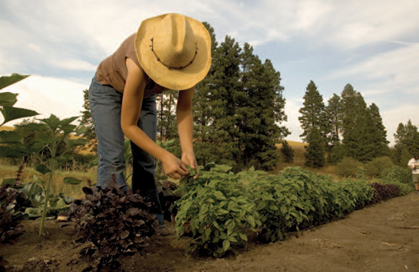
Are you a “Reel” Woman?
Imagine this: Cool water flowing along a rocky stream bed invites you toward the pebbled bank. You drop your gear and start preparing your line. When the hook is baited, you cast gracefully upstream and watch the line float down just short of the tangle where you know the fish are gathered. Time to wade out into the water. You squeal when the chill hits your ankles but push on until it reaches the cuff of your shorts. This is the stuff “tough” is made of. Yep, you’re a “reel” woman.
 You Get a Line, I’ll Get a Pole …
You Get a Line, I’ll Get a Pole … 
If you’ve ever had the urge to fish, there’s no better time than now. After all, you’re on the loose!
• Women of all backgrounds and experience levels are wading into the water to satisfy their wildest urges. There are over 17 million female anglers in the U.S. who are passionately reclaiming their right to America’s last sacred sport.
• Unfamiliar with the territory? You’ll find lots of helping hands to guide you on your journey. From bait, flies, and old-timer tips to fillets in the frying pan, you’ll find the know-how you’ll need to start.
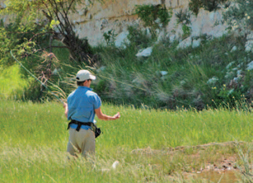
Sisters on the Fly
is a growing group of women who caravan around the country in cute vintage trailers, fishing, running rivers, and having “more fun than anyone.” They’ll show you the ropes and spoil you rotten. Learn more at SistersOnTheFly.com.
Loyal Order of the Glamper (“Tis better to glamp than camp.”)
is based online and they occasionally meet up here and there in smaller groups. No fees to join, no rally dues. Online conversations contain a wealth of information, everything from how to paint your barbeque grill pink to trailer renovations to trailers for sale. Learn more at LoyalOrderOfTheGlamper.com.
Farmgirls on the Loose
was started by women who are dues-paying members of MaryJane’s Farmgirl Sisterhood, now numbering 4,000 plus. Learn more at FarmgirlsOnTheLoose.org.
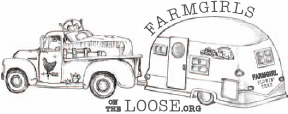
Feeling Sporty?
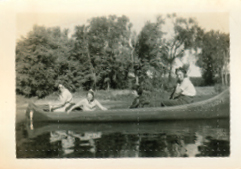
If outdoor sporting is your game, the world is your oyster.
Whether it’s a restful yoga retreat you relish or a wet-’n’-wild rafting adventure, here are starting points for embarking on your sporty sabbatical:
• Online directory of yoga retreats, instructors, and facilities worldwide
• Straightforward list of stables by state with contact information and a brief description of services for each listing
• Women’s Yoga and Horsemanship Retreats
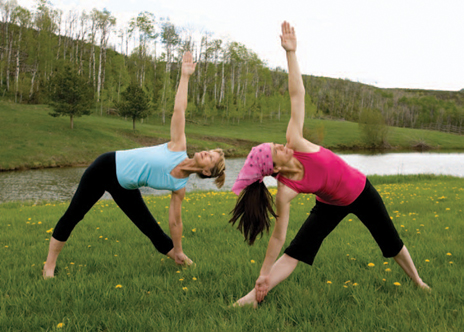
• Easy day hikes, tough treks, biking trails, and extended overnight backpacking trips throughout North America
• In-depth access to trail maps, driving directions, and detailed descriptions of routes
• Links to USGS topographic maps as well as photos, trail elevation profiles, regional locator maps, and interesting facts about the natural, geographical, and historical significance of various hikes and regions
• Top-notch guide service for river and coastline rafting trips worldwide
• More trip options than any other North American Whitewater rafting company
• Trips tailored to your experience level and limited to small groups, maintaining the best guide-to-guest ratio in the business
Go Geocaching
This fun-for-all-ages game puts an exciting new spin on traditional scavenger-hunt expeditions.
It can be played just about anywhere, and since players can also log on to a website to record their findings, the game offers the added thrill of connecting outdoor adventurers around the globe.
• Geocache locations range from city parks to mountaintops, so you’re likely to find one (or more) along the way.
• Search for sites and learn more about the game at Geocaching.com.



What woman doesn’t love to go junktiquing?
If your’e an impassioned picker of eclectic “junk” (affectionate term for antiques, collectibles, and can’t-live-without kitschy knick-knacks), a road trip is a fabulous excuse for a junking jaunt.
Of course, a seasoned picker can track down splendid, spontaneous treasures as she travels, but why not pinpoint a few intriguing destinations before you set sail? Mark hot spots on your map using these websites: AntiquesNavigator.com and FindAFleaMarket.com.
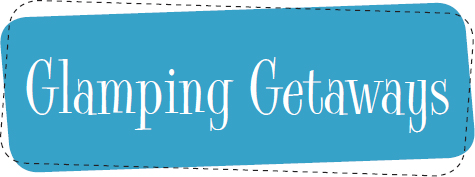
Choosing a 5-Star Glamping Experience

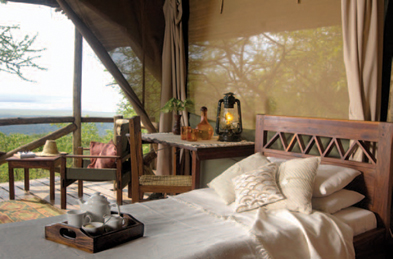
Kirurumu, Tanzania Kirurumu.net
 Regardless of budget, you can enjoy the great outdoors without sacrificing luxury.
Regardless of budget, you can enjoy the great outdoors without sacrificing luxury.


The easiest way to keep up on the latest news and updates about glamping events and getaways?

Creating Your Own 5-Star Glamping Experience

Glamping doesn’t have to happen away from home. If you have a back yard, a rooftop, a porch, a deck, or a small patch of grass under a cool shady tree, you can have a glamping spot all your own. It’s easy! Decorate your deck with pretty accents. Plump up some soft, white pillows and sleep under the stars. Adorn that old picnic table with a handful of candles and a pitcher overflowing with your favorite flowers. Selecting a bit of personalized glam and hauling it out your back door is what glamping is all about. When a woman gets that glamping look in her eye, nothing in her immediate outside world is ever the same.

“My glamping checklist includes a vintage picnic basket that has real china and real silverware in it, along with cloth napkins, tea towels, dishcloths, some cooking utensils, etc. And YES, there are china teacups with saucers in there.”
– CJ, Colorado
“How wonderful that you and your grown daughter are able to break away to go glamping. I love all the fanciness you did. I would love to do that, but I have a hubby who would never put up with that much girly stuff. But LOOK OUT once I get a canopy up in my yard!!!!”
– Janet, Michigan
“Thanks, Janet. We don't do it that way when our husbands are camping with us. We tell them we are going "glamping" and they KNOW it's girl camping and there will be girly stuff galore. If our husbands come, it's a whole different animal.”
– CJ and Robin

Glamper Wisdom
When smoking a fish, never inhale.
If you value your privacy, place a tuba outside your glamper


My girlfriends are the sisters
I picked out for myself.
 For there is no friend like a sister, in calm or stormy weather, to cheer one on the tedious way, to fetch one if one goes astray, to lift one if one totters down, to strengthen whilst one stands.
For there is no friend like a sister, in calm or stormy weather, to cheer one on the tedious way, to fetch one if one goes astray, to lift one if one totters down, to strengthen whilst one stands.
– Christina Rossetti
Gather up, girlfriends!



10 Tips for the Girl Camping Hostess
(from Girl-Camping.blogspot.com)
Are you ready to share your yen for camping by staging a gathering for fellow girl campers? If so, we salute you—because someone has to be the hostess if there are going to be camping parties for others to enjoy!
These are some tips you might find helpful as you make your mostest-hostess plans:
1. Let your guests know what to expect/what to bring.
Examples: Are pets OK? Are meals provided, or are you planning for potluck contributions? Are water and power available, or is this a dry-camping event? Will your guests need any special clothing or gear—swimsuit, party outfit, fishing gear, etc.? Should they bring firewood? Will they need money for meals out, special entertainment, campsite fees, shopping?
2. Provide a GPS address in addition to written directions.
It’s now very common for drivers to use a GPS rather than written directions, and we understand why, especially when towing a trailer. It’s not always easy to turn a trailer around if you take a wrong turn, nor to read from a sheet of paper while doing the driving. You will have happier guests if they don’t have to “undo” being lost in the effort of trying to find you.
3. Post signage at the last couple of intersections.
Put yourself in a first-timer’s shoes—even with a GPS, it’s always nice to know that you’re going the right way as you get close to an event site.

4. Be ready to help with parking.
Many gals are rookies at parking a trailer, and even the more experienced ones will appreciate having a spotter as they do their maneuvering into a parking spot.
5. Provide a nametag for every guest.
These can be as simple or as creatively elaborate as you wish. They’re important, in any case, because they help to break the social ice and make it easy for everyone to learn and remember names. (Of course, if you’re only inviting those who know each other already, this step isn’t so important.)
6. Create a central gathering spot and mark it.
Everyone likes to know where they can go for questions, meals, departures for activities, and so forth. We love using a large, stand-up chalkboard for this purpose—messages and memos can easily be changed—but do whatever works for you.
7. Make the first night’s meal flexible and easy.
Chances are, your guests will be trickling in over a span of time (some will arrive late if they’ve had to work that day), and that they’ll also be consumed by getting set up once they do arrive. A hot-dog roast is a good way to go, with or without some crockpot dishes that don’t have to be served at a specific time. If the first night will be an “on your own” meal night, be sure to let everyone know that ahead of time.
8. Set a time for trailer-touring.
Every girl camper we’ve ever met just loves to show off her trailer and all its goodies to her fellow campers (if not to the general public). But let’s face it—when you’re camping in a trailer, it’s not always as tidy as you’d like, and it takes a little time to glam it back up. So it’s just nice for your guests to know when they can expect to have camera-toting company!

9. Take good care of your new gals.
Think back to the first time you took your camping rig somewhere public, and/or the first time you camped with women you didn’t know. Were you uncertain? Shy? Scared you wouldn’t fit in? Worried that you didn’t have everything “perfect”? Afraid to ask any questions? This will help you remember to pay extra attention to those who are new and to keep them under that welcoming wing.
10. Prepare for the unexpected.
It’s always a good idea to keep a first-aid kit handy, and to keep an ICE (In Case of Emergency) number for every guest. Emergency-room addresses/directions can come in handy, too. As careful as we all try to be, accidents and injuries can and do sometimes happen, and as hostess, you’ll be the ipso-facto person in charge.
Now—add in your own special planning, get those invitations out, and get ready for an awesome time!

National Parks, etc.

As in, “I hitched up my vintage trailer and headed out to the boondocks to escape the hubbub of the city.”
But, wait—there’s a new twist on the term that hasn’t hit the dictionaries (yet). Want to try it? Repeat after me:
“Come on, girls, let’s round up the wagons and go boondocking this weekend!”
Yep, boondocking.
It means camping in remote, rural, or provincial areas. Off the beaten paths of conventional campgrounds. Off the grid. Toss “boondocking” out in a conversation with seasoned trailer travelers, and some will be savvy.
“All the cool campers do it,” they’ll say.
Boondocking can also be referred to (in tamer terms) as “dispersed camping,” which government agencies like the U.S. Forest Service deem “camping outside developed campgrounds.”
The gist is this: boondocking offers a bit more rugged camping experience, but it’s footloose—and free.
Pros:
Cons:
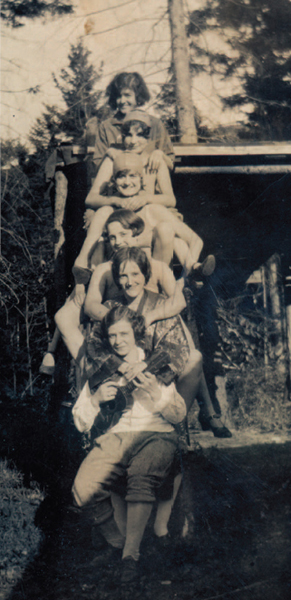

Boondocking on private land can be tricky.
Even when visiting friends and family, there may be city or county regulations that prohibit RVs or other trailers from parking on streets (private driveways are fair game). A quick call to the local police station will tell you if street parking is legal.

In rural areas, you may be able to boondock on a private ranch or farm. If you happen upon a great spot and can locate the landowner, it never hurts to ask.
In a pinch, boondocking in a parking lot is a possibility. If you’ve been driving for hours and need a rest, businesses like WalMart, K-Mart, Costco, and Cracker Barrel, and various grocery stores, churches, and other businesses, may allow overnight parking in their lots. During business hours, you can pop inside and ask permission. Often, these lots are protected by security cameras and guards, making them a safer sleeping option than, say, a dark alley. Again, check with local law enforcement to avoid being ousted in the middle of the night.
Public Land

As a general rule, boondocking is allowed anywhere on federal public lands within 300 feet of any established road, and 200 feet from water sources (creeks, lakes, etc).
Federal Land Administrators:
• U.S. Forest Service (www.FS.Fed.us)
• Bureau of Land Management (BLM.gov)
• Army Corps of Engineers (www.USACE.Army.mil)
• Bureau of Reclamation (www.USBR.gov)
• U.S. Fish and Wildlife Service (www.FWS.gov)
Note: National parks do not allow boondocking.
State agencies may also allow boondocking, but it’s best to check with your state’s land management agencies to be sure.
Unless an area is restricted from dispersed camping, you can simply stake out a perfect spot and set up camp. Of course, boondockers are encouraged to make minimal impact on the land. The “Leave No Trace” concept is key when you’re camping outside designated campgrounds that undergo regular garbage patrols and maintenance. Your best bet is to make use of previously established boondock campsites where you’ll find a convenient place to park and an existing campfire ring.
In most boondocking-friendly areas, you can stay 14 continuous days for free, but subsequent camping days must be 25 miles away. Exceptions include Bureau of Land Management Long-term Visitor Areas, which allow stays of several months for a nominal fee.

How to Find Boondocking Sites in Advance
The USA Camping Map at RV-Camping.org has links to each state’s public lands administrators’ websites—a great place to start looking for boondocking locations.
Arm yourself with good maps such as Benchmark Maps or Atlas & Gazetteers by DeLorme Publishing Company. These maps highlight federal and state lands as well as established campgrounds that can serve as jump-off points for boondockers. Contact local public lands administrators for specific regulations.
For the technologically inclined, a Web application at Boondocking.org allows you to enter GPS coordinates for your favorite camping spots and find other spots near your current location. You can also search for free automobile-accessible camping areas based on a distance from a given latitude and longitude point.

Traditional RV Campgrounds
If boondocking isn’t your style (and who doesn’t love running water and electricity once in a while?), then there are tons of conventional RV campgrounds that provide parking spots, hookups, restrooms, and other facilities for a fee. Find a site at RV There Yet (RVThereYet.cc).

Business on the Road in Your PJs
(you can run, but they will find you)
Let’s face it: You can run, hop the fence, hightail it to the horizon—but it will find you.
What’s tracking you down?
Work, my friend. The daily grind.
Let me tell you from experience that it’s tough to get all the way off the grid, even on vacation.
Work has a way of sniffing you out, and, before you know it, it’s hot on your trail.
Unless you’re prepared to get die-hard and ditch communication while you’re traveling, you’ll need a way to stay connected that’s simple and reliable, whether you’re in an RV park or a remote boondock camp.
The word we’re looking for here is “wireless.” In techie-talk, it’s “WiFi,” pronounced why-fie. (We all know why-pie?)

In short, these terms refer to the technology used to make computers and mobile phones work via signals that bounce around “out there” in space. Get the gadgets that suit your style, and you’ll have on-the-road access, no physical connections needed.

Even if you’re bent on leaving business in the rearview mirror, wireless Internet capabilities can come in handy. You’ll love being able to Google, scout out stuff to do, check weather forecasts (check knitting forecasts?), e-mail, and blog about your adventures along the way.
The top three options for wireless Internet while road tripping are:
WiFi hotspots
(available free at certain locations like airports and coffee shops)
mobile
(cell phone service networks based on transmitting towers)
satellite
(based on satellite signals)
Mobile Basics
Pros:
• works anywhere you get cell-phone reception
• allows mobile Internet access (you can connect while driving)
• costs less than satellite
• download speeds don’t fluctuate with weather conditions
Cons:
• without cell reception, you can’t connect to the Internet
Equipment You’ll Need:
• computer or handheld device
• access to a service provider’s network and modem (usually provided by carrier)
• router (optional, for accessing your connection with laptops or handhelds)
• booster antenna (optional, for boosting a weak signal due to your location or your trailer’s construction—Airstreams and metal teardrops, take note)
When shopping for a service provider (also called a carrier), ask about:
• coverage where you might be traveling (some providers offer greater areas of cell signals than others)
• bandwidth (speed) and the amount of data allowed based on their service plan (to stream media or download large files, you may need more of both)
• cost and contract terms
Service Providers:
• VerizonWireless.com (so far, the best for rural coverage)
• ATT.com (AT&T)
Satellite Made Simple
Pros:
• works anywhere, no matter how remote
Cons:
• costs more than mobile (system and installation costs plus monthly service)
• only allows stationary Internet access (you can’t connect while driving)
• download speeds can lag during inclement weather
• satellite dish requires a clear “line of sight” to the sky
• usually slower than mobile
Equipment You’ll Need:
• computer or handheld device
• satellite dish and modem (usually provided by carrier)
• mounting bracket (for auto-point systems)
• tripod, GPS, and compass (for manual-point systems)
An auto-point satellite system is, as the name implies, fully automatic. The dish is mounted to the outside of your trailer, and when you come to a stop, it rotates to find the best signal. This option will pinch your pocketbook, with system and installation costs soaring up into the $5,000 to $7,000 range, and there are monthly service fees to boot.
Auto-Point Installation Companies:
A manual-point system is cheaper ($1,000 to $2,500 to install), but it’s not as easy to use. Hands-on manipulation is necessary each time you want to connect to the Internet. You have to set up a tripod, determine your location via GPS, point your dish with the aid of a compass, and so on. Then there’s the fine print: mobility (dish transport) is not officially approved by installation companies, so you can’t call for help with pointing the dish properly.
Manual-Point Installation Companies:

It isn’t beware of dog, it’s BEWARE!—kids and pets on board.

A dog harness keeps Fido secure and protects drivers and passengers. Kurgo.com
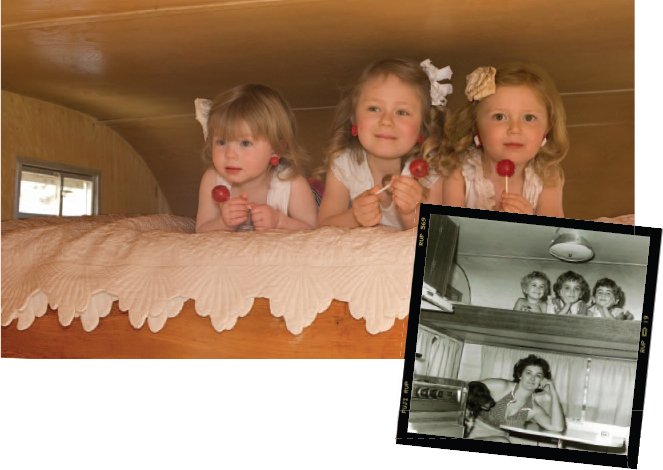
I’m intent on instilling a love of glamping in my grandgirls, so we schedule what they call “Nanny night.” Dogs and children allowed. Also allowed? …
Campfire dinners, costume jewelry (Nanny brings plenty to choose from), outdoor bathing, late-night storytelling, sleeping-bag toe tickling, treasure hunts, and TEA. I’ve conditioned my grandgirls to stop for tea with me to sip what I call a London Fog—white tea with milk (fresh from my cow). The tea part of glamping with kiddos gives me a much-needed pause because the one bit of solid, irrefutable advice I have about glamping with kids is this: Make them the center of your attention, pretty much the only thing you’re doing (the reason you’ll need scheduled tea breaks). If kids are an add-on or an aside when you venture outside, everyone ends up frustrated because kids are so ravenously curious about every detail nature has to offer. Plus, they’re without their usual technological distractions—you’re it!
And our doggie poohs? Ruffing it with dogs comes down to one simple rule—leave only paw prints (you know what I’m talking about). The Sisters on the Fly (p. 186) are fond of saying, “We have no rules except one: No husbands, kids, or dogs.” Can you imagine the glamping sister who pulls her trailer to an event and her dog barks all night or overturns the first night’s potluck table? Never a good thing. Traveling can be stressful for dogs. In other words, don’t expect your dog to spend the day in a car, get into camp, and settle down for the night. Allocate time to walk and play with your dog. Rules regarding dogs and campgrounds are becoming increasingly strict, for good reason. Consider enrolling your dog in the AKC’s Canine Good Citizen program. Public campgrounds that frown on dogs are more likely to welcome your dog if you can show them your dog is certified well-behaved.
Glamping with Nanny

The first thing a glamping gal does is find flowers for her hair and the dinner table.

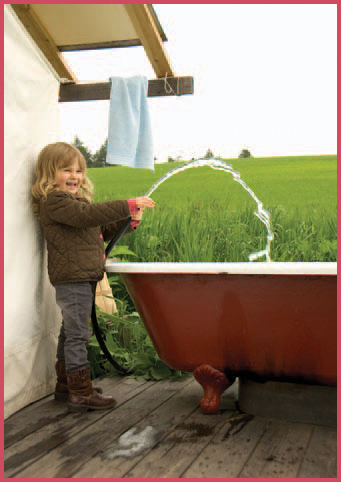
I scout around and find firewood so Nanny can get our campfire started.


Then I help with preparing the outside bath. I use a garden hose to fill the tub with cold water, and Nanny lights a propane burner beneath it. After dinner and s’mores, the water will be perfect and we’ll take a bath under the stars.


To the gardens we go for potatoes, garlic, shallots, carrots, and basil. I stop at the henhouse to gather eggs for breakfast. Nothing but organic for our hobo dinner! I LOVE eating bell peppers as if they’re apples.

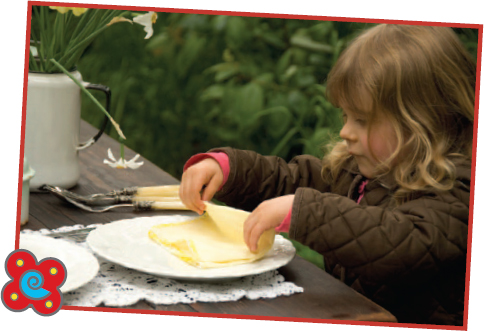
Nanny puts our hobo dinners (p. 177) right in the campfire to cook and I set the table for dinner.
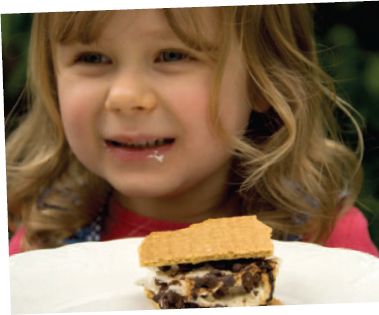
Now on to dessert! This glamper makes s’mores using Nanny’s homemade marshmallows (p. 180). You haven’t tasted marshmallows until you’ve tasted REAL marshmallows like ours toasted over a campfire, rolled in mini chocolate chips, and smooshed between two graham crackers.
Oh my!

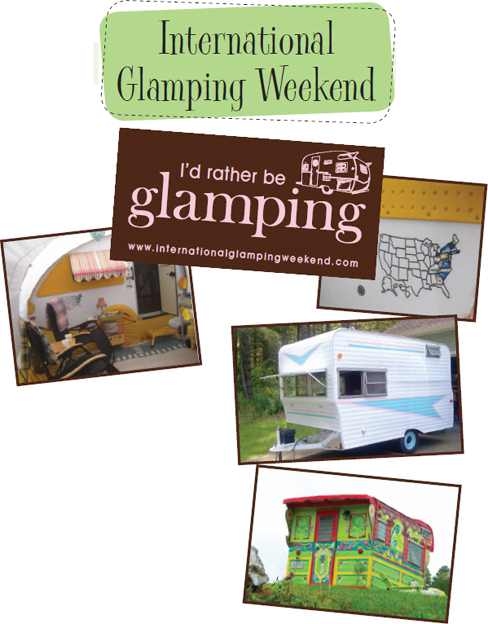
When I came up with the idea for an international glamping celebration, I was trying to accomplish two things. First, I knew glampers would love the idea of a designated weekend dedicated to outdoor fun. Second, I felt like the glamping trend was catching on big-time (glamping this and glamping that showing up everywhere here and there), but the glamping movement was in need of only ONE website, one hub, where we could find an all-inclusive list of glamping websites or blogs, in addition to a current “glamping in the news” section, as well as a complete run-down of glamping gatherings.
Thinking about buying a trailer? Remodeling the one you have and need help with what propane fridge to buy? Looking for some decorating ideas?
International Glamping Weekend is it, glampers! It’s THE hub, THE happenin’ place for all things glamping.
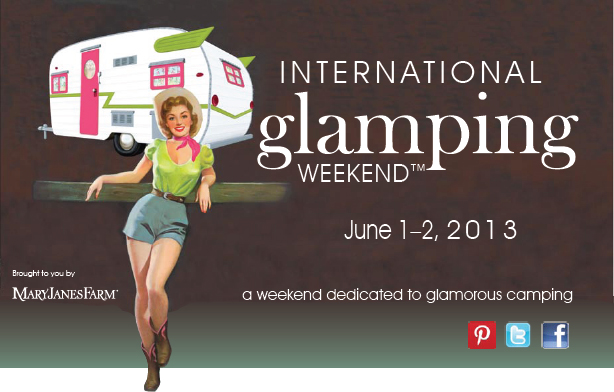
With news giants like The New York Times, Wall Street Journal, The Today Show, and CNN finally giving glampers their due, it’s high time for an official, designated glamping weekend. And who else to decree it but the woman (moi) who pioneered the concept?
Fire up your dream machine! There is a glamping round-up every year the first weekend in June, anywhere in the world (back yards, rooftops, and city parks notwithstanding). Dust off your prom dress, pack up your mule, load up on chocolate, and gather up your glamping gal friends. This is the website where, finally, all of us glamper types are showing up on the same page. If I’ve missed your website or blog, give a hoot, give a holler, I’m all yours. And if you have ideas for other ways I can honor and showcase what we’re about, I’m all ears.
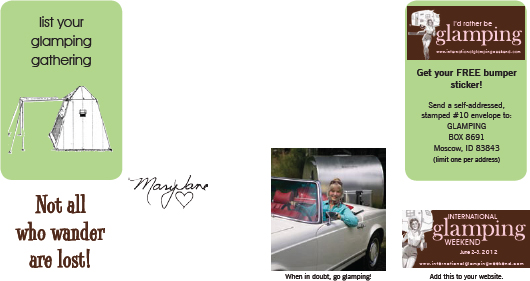
Glamping in the News
• Luxury Camping for Comfort Queens – 7 Top Glamping Destinations (featuring MaryJanesFarm), Wicked Good Travel Tips, April 2012
• Glamping in Idaho (featuring MaryJanesFarm), Glamping Girl, March 2012
• 20 Decadent Glamping Photos (featuring MaryJanesFarm), BuzzFeed, March 2012
• Glamping It Up, Irish Times, March 2012
• Australia’s Most Glamorous Camping Destinations, Huffington Post, February 2012
• Glamping, Florida Style, VisitFlorida.com, February 2012
• Glamping Hub Puts High-end Camping on the Map, Travel Daily News, February 2012
• ‘Glamping’ Will Let You Experience the Great Outdoors with Creature Comforts, TheLedger.com, February 2012
• Glamping: Where Nature Meets Luxury, Yahoo! Finance, December 2011
• A Guide to “Glamping” Around the World, Condé Nast Traveler, December 2011
• Pioneer of “Glamping” Helps Americans Unplug and Stay Healthy (featuring MaryJanesFarm), Black Enterprise, Boston Globe, Charlotte Observer, Cincinnati Enquirer, Columbus Dispatch, FinanzNachrichten.de, Houston Chronicle, Market Watch, Miami Herald, Morning Star, NY Daily News, San Jose Mercury News, SFGate.com, Synacor, Yahoo! Finance, December 2011
(and more!)
Glamping Websites & Blogs
• Adeeni Design Blog—Luxury Camping: I am definitely a glamper, not a camper
• Alison Travels
• A Little Campy
• Bargain Hoot—Glamping: glamorous camping!
• Becoming an Outdoors Woman
• Brown Folk Festival—How to Go ‘Glamping’—That’s Glamorous Camping
• Camp and RV Cook
• Camping in Heels
• Camping in Montana
• Camping Road Trip
• Camping USA
• Camping Women
• The Everyday Gourmet food blog
• Farm Stay U.S.
• Flickr Glamping Group
• Giddy Up 4 Branson
• Ginger Goes Glamping (and more!)